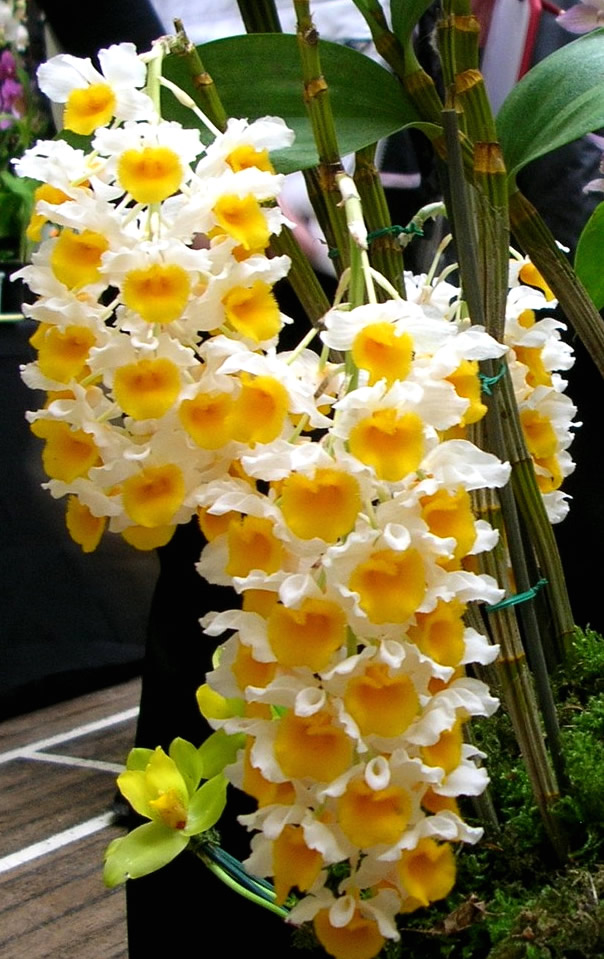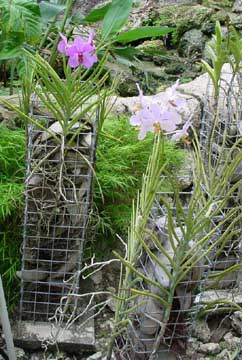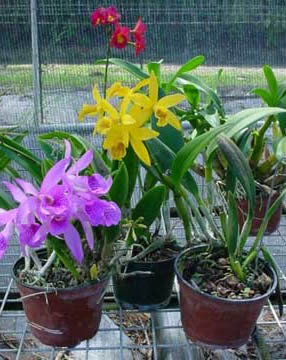
|
Orchid (Dendrobium thyrsiflorum)
|
Characteristics
Orchids are noted for their beautiful, long-lasting flowers, widely differing in
shape, size and colour. They belong to the family Orchidaceae, which comprises over
600 genera, 30000 species and thousands of man-made hybrids.

|

|
|
Monopodial
|
Sympodial
|
Orchids have varying habitats but epiphytic orchids dominate the trade. They are
also classed as monopodials (stems having a vertical growth, non-branching, with
aerial roots) and sympodials (stems having a horizontal growth, producing pseudobulbs
in clusters, no aerial roots).
The ideal location for orchid growing is in the open conditions, under appropriate
level of shade nets. In Kerala it is also grown under the shade of coconut trees
above 10 years old.
Most attractive orchids belong to the group of epiphytes, which require free moving
air at all times. The orchid plants produce aerial roots, which absorb water and
nutrients from the atmosphere. Both terrestrial and epiphytes grow under varying
levels of shade. Plants grown under deep shade will have good vegetative growth
and poor flowering. Hence shade and light regulations are very important operations
for better flowering. This requirement varies with the species and varieties. Some
species grow in open sunlight. A humid and warm atmosphere is congenial for the
growth of most of the tropical orchids. Better results are obtained when the atmospheric
humidity is 50 to 80%. Orchids require proper temperature for good growth and flowering.
Accordingly there are tropical, subtropical and temperate orchids.
Top
Varieties
The popular genera of orchids that are suitable for growing in Kerala are Arachnis,
Aranthera, Vanda, Phalaenopsis (monopodials); Aranda, Mokara (inter-generic
monopodials); Dendrobium, Cattleya, Oncidium (sympodials).
Dendrobium is the most popular genus of Kerala. Some of the important varieties
belonging to this genus are given below, grouped according to colour.
Purple and white: Sonia 17, Sonia 28, Sonia Bom Jo, Earsakul
Purple: Renappa, New Wanee, Sabine Red, Jurie Red, Master delight and Velvet soft
White: Emma White, Fairy White, Kasem White, Snow White
Pink: Sakura Pink, New Pink, Lemon glow and Pink cascade
Yellow: Sherifa Fatimah, Kasem Gold, Tongchai Gold
Magenta: Deep blush
Top
Propagation and planting
The conventional method of propagation is by vegetative means. Monopodial orchids
are propagated by stem cuttings. Terminal cuttings with one or two healthy aerial
roots are ideal as planting material. Basal cuttings of 30 cm length with a few
roots and leaves are also good. But they take longer time to sprout and grow. Sympodial
orchids are propagated by separation of pseudobulbs. A plant with minimum two or
three pseudobulbs with the basal root is ideal for planting. Some of the sympodial
varieties produce sprouts at the top of pseudobulb called as keikis. Keikis when
fully grown can be separated and planted. Besides, back-bulbs or spent canes (shoots
that have ceased to produce flowers) before they shrivelled can be severed from
the mother plant and placed horizontally over the medium to stimulate sprouting
of new shoots.
Seed propagation is possible only under aseptic conditions. Seedlings produced by
embryo culture will take 2-5 years for flowering, depending on the genus.
Meristem culture is very effective in large-scale propagation of orchids.
planting
Terminal cuttings of monopodial orchids are planted loosely on old coconut husks
at a spacing of 30 cm between plants and 45 cm between rows in long beds. There
can be two or three rows in a bed. Basal cuttings will sprout within a period of
two months. Partial shade up to 50% is required for sprouting. Basal cuttings are
planted close to each other in nursery beds for sprouting. After sprouting they
are planted at the recommended spacing. Monopodial orchids can be grown on ground
above soil level. A thick bed of 15-20 cm height is loosely arranged. Well-dried
coconut husks are better than fresh husks. Sympodial orchids are grown on benches
above ground level or suspended from above. Slotted wooden baskets filled with small
pieces of dried coconut husk or partially burnt charcoal is good for plant growth.
Planting is done above the medium with a support for proper anchorage.
Planting can also be done in pots or other containers. Mud pots of 10-20 cm diameter
with several large holes on the side and bottom, filled with tile bits, chopped
coconut husk or charcoal are used for planting. Both monopodial and sympodial orchids
are to be supported properly since the planting is done above the medium. A clear
solution of fresh cowdung can be used for irrigation for a few days. Dipping in
fresh cowdung solution before planting also gives good results.
Top
Manuring
Monopodial orchids grown on ground can be given cowdung slurry once in a month.
One kg fresh cowdung mixed in 5 litres of water is sufficient for one square metre.
Two to three applications can be given in a year. Sympodial orchids are sprayed
with the supernatant liquid of cowdung slurry.
Nutrition of plants from the natural sources is not sufficient to support the plants
for economic production. Hence additional feeding is required.
Foliar feeding is very effective in orchids. Fertilizer mixture of N:P2O5:K2O
3:1:1 can be applied during vegetative period and 1:2:2 can be applied during flowering
period. The usual dose of such mixture is 2-3 g per litre of water, applied twice
a week.
Top
Plant
protection
Diseases
The important fungal diseases are:
Leaf spot (Colletotrichum and Gloeosporium)
Leaf blight (Pythium)
Collar blotch (Penicillium thimmi)
Collar rot (Sclerotium)
Orchid wilt (Sclerotium rolfsii)
These can be controlled by application of mancozeb, carbendazim etc. at the recommended
dose. Spraying should be done prior to the commencement of monsoon and at fortnightly
intervals during heavy monsoon. Important virus diseases are mosaic and ring spot.
Destroying the affected plants can control spread of these diseases.
Pests
The common pests attacking orchids are thrips, aphids, spider mite, soft scale,
mealy bugs, orchid weevil, ants etc. Insecticides at suitable concentration can
control all the insects. Other very serious pests of orchids are snails and slugs.
They feed on the tender young shoots, roots and buds. Hand-picking is effective,
if the number of plants is less. They move out during late night and hide before
early morning. Damage is caused during this period. All the pests can be controlled
by application of contact and systemic insecticides at appropriate concentration.
Harvesting
The spikes are harvested when all the buds of the spike except two or three are
open depending on the genus.
Top
|